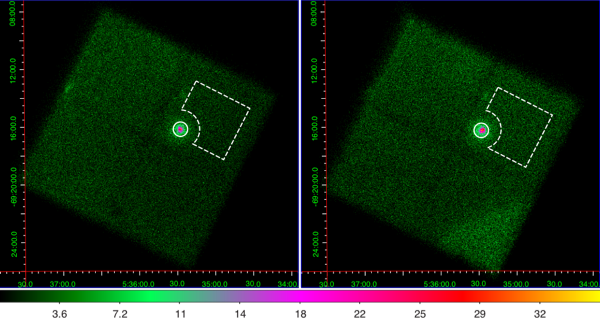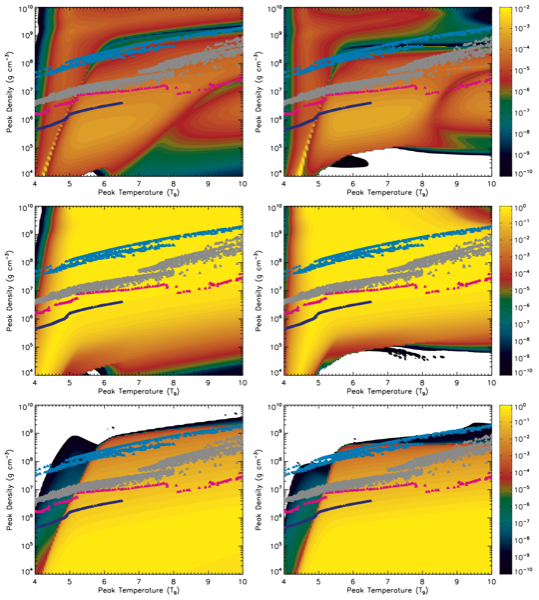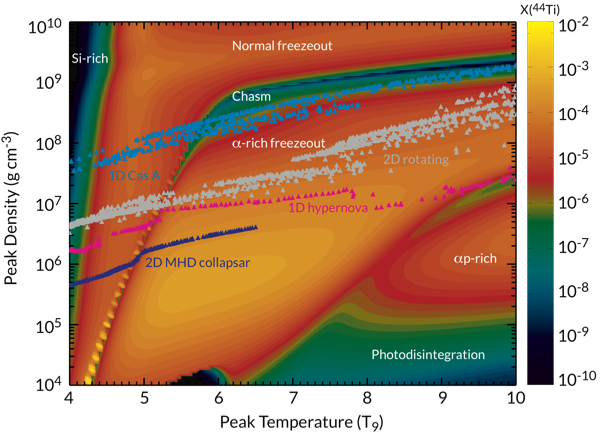
|
Cococubed.com
|
|
44Ti, 60Co & 56Ni From Supernova Explosions |
Home
Astronomy research
Software Infrastructure:
MESA
FLASH-X
STARLIB
MESA-Web
starkiller-astro
My instruments
Neutrino Emission:
Neutrinos from de-excitation
Neutrino emission from stars
Identifying the Pre-SN
Neutrino HR diagram
Pre-SN Beta Processes
Pre-SN neutrinos
White dwarf pulsations:
12C(α,γ) & overshooting
Probe of 12C(α,γ)16O
Impact of 22Ne
Impact of ν cooling
Variable white dwarfs
MC reaction rates
Micronovae
Novae
White dwarf supernova:
Stable nickel production
Remnant metallicities
Colliding white dwarfs
Merging white dwarfs
Ignition conditions
Metallicity effects
Central density effects
Detonation density
Tracer particle burning
Subsonic burning fronts
Supersonic fronts
W7 profiles
Massive stars:
Pop III with HST/JWST
Rotating progenitors
3D evolution to collapse
MC reaction rates
Pre-SN variations
Massive star supernova:
Yields of radionuclides
26Al & 60Fe
44Ti, 60Co & 56Ni
SN 1987A light curve
Constraints on Ni/Fe
An r-process
Effects of 12C +12C
Neutron Stars and Black Holes:
Black Hole spectrum
Mass Gap with LVK
Compact object IMF
He burn neutron stars
Stars:
Hypatia catalog
SAGB stars
Nugrid Yields I
He shell convection
BBFH at 40 years
γ-rays within 100 Mpc
Iron Pseudocarbynes
Pre-Solar Grains:
C-rich presolar grains
SiC Type U/C grains
Grains from massive stars
Placing the Sun
SiC Presolar grains
Chemical Evolution:
Radionuclides in 2020s
Zone models H to Zn
Mixing ejecta
Thermodynamics, Opacities & Networks
Radiative Opacity
Skye EOS
Helm EOS
Five EOSs
Equations of State
12C(α,γ)16O Rate
Proton-rich NSE
Reaction networks
Bayesian reaction rates
Verification Problems:
Validating an astro code
Su-Olson
Cog8
Mader
RMTV
Sedov
Noh
Software Instruments
2026 AAS Journals
AAS YouTube
Listing of 500+ Author Videos
AAS Peer Review Workshops
Outreach Material
Education Material
Other Stuff:
Bicycle Adventures
Illustrations
Presentations
Contact: F.X.Timmes
my one page vitae,
full vitae,
research statement, and
teaching statement.
Observations - (2018)

44Ti Cas A map Grefenstette et al 2017 |

44Ti SN 1987A map Boggs et al 2015 |

44Ti SN 1987A Boggs et al 2015 |

COMPTEL 44Ti Cas A Diehl et al 1998 |

COMPTEL 44Ti Vela Oberlack et al 1994 |

COMPTEL 44Ti Vela map |
The light curve of SN 1987A revisited: constraining production masses of radioactive nuclides (2014)
In this effort, we revisit the evidence for the contribution of the long-lived radioactive nuclides $^{44}$Ti, $^{55}$Fe, $^{56}$Co, $^{57}$Co, and $^{60}$Co to the UVOIR light curve of SN 1987A.
Trends in 44Ti and 56Ni from Core-collapse Supernovae (2010)
In this article we compare the yields of 44Ti and 56Ni produced from post-processing the thermodynamic trajectories from three different core-collapse models – Cassiopeia A progenitor, a double shock hypernova progenitor, and a rotating two-dimensional explosion – with the yields from exponential and power-law trajectories.
The peak temperatures and densities achieved in these core-collapse models span several of the distinct nucleosynthesis regions we identify, resulting in different trends in the 44Ti and 56Ni yields for different mass elements. The 44Ti and 56Ni mass fraction profiles from the exponential and power-law profiles generally explain the tendencies of the post-processed yields, depending on which regions are traversed by the model. We find that integrated yields of 44Ti and 56Ni from the exponential and power-law trajectories are generally within a factor two or less of the post-process yields. We also analyze the influence of specific nuclear reactions on the 44Ti and 56Ni abundance evolution. Reactions that affect all yields globally are the 3$\alpha$, p($e^{-}, \nu_e$)n and n($e^{+},\overline{\nu_e}$)p. The rest of the reactions are ranked according to their degree of impact on the synthesis of 44Ti. The primary ones include 44Ti($\alpha,p$)47V, 40Ca($\alpha,\gamma$)44Ti, 45V($p,\gamma$)46Cr, 40Ca($\alpha,p$)43Sc, 17F($\alpha,p$))20Ne, 21Na($\alpha,p$))24Mg, 41Sc($p,\gamma$))42Ti, 43Sc($p,\gamma$))44Ti, 44Ti($p,\gamma$))45V, and 57Ni($p,\gamma$))58Cu, along with numerous weak reactions. Our analysis suggests that not all 44Ti need to be produced in an α-rich freeze-out in core-collapse events, and that reaction rate equilibria in combination with timescale effects for the expansion profile may account for the paucity of 44Ti observed in supernova remnants.
The data for the contour plots along with source code to interpolate within the 3D data cube of initial temperature, density, electron fraction Ye are in interpolate_abundances.tar.xz.

|

|

|
|
Contraints on the progenitor of Cassiopeia A (2006)
In this article we compare a suite of three-dimensional explosion calculations and stellar models incorporating advanced physics with observational constraints on the progenitor of Cassiopeia A. We consider binary and single stars from 16 to 40 M⊙ with a range of explosion energies and geometries. The parameter space allowed by observations of nitrogen-rich high-velocity ejecta, ejecta mass, compact remnant mass, and 44Ti and 56Ni abundances individually and as an ensemble is considered. A progenitor of 15-25 M⊙ that loses its hydrogen envelope to a binary interaction and undergoes an energetic explosion can match all the observational constraints.
44Ti and 60Co - 1996
In this article, we explore the production of the radioactive isotopes 44Ti and 60Co in all types of supernovae is examined and compared to observational constraints including Galactic γ-ray surveys, measurements of the diffuse 511 keV radiation, γ-ray observations of Cas A, the light curve of SN 1987A, and isotopic anomalies found in silicon carbide grains in meteorites.
The (revised) line flux from $^{44}$Ti decay in the Cas A supernova remnant reported by COMPTEL on the Compton Gamma Ray Observatory is near the upper bound expected from our models. The necessary concurrent ejection of $^{56}$Ni would also imply that Cas A was a brighter supernova than previously thought unless extinction in the intervening matter was very large. Thus, if confirmed, the reported amount of $^{44}$Ti in Cas A provides very interesting constraints on both the supernova environment and its mechanism. The abundances of $^{44}$Ti and $^{60}$Co ejected by Type II supernovae are such that gamma-radiation from $^{44}$Ti decay SN 1987A could be detected by a future generation of gamma- ray telescopes, and that the decay of $^{60}$Co might provide an interesting contribution to the late-time light curve of SN 1987A and other core collapse supernovae. To produce the solar $^{44}$Ca abundance and satisfy all the observational constraints, nature may prefer at least the occasional explosion of sub-Chandrasekhar mass white dwarfs as Type Ia supernovae. Depending on the escape fraction of positrons due to $^{56}$Co made in all kinds of Type Ia supernovae, a significant fraction of the steady state diffuse 511 keV emission may arise from the annihilation of positrons produced during the decay of $^{44}$Ti to $^{44}$Ca. The Ca and Ti isotopic anomalies in presolar grains confirm the production of $^{44}$Ti in supernovae and that extensive mixing between zones has occurred, but a quantitative model for this mixing is presently lacking.

|

|

|
|
Experiments

AMS of 44Ti |

|